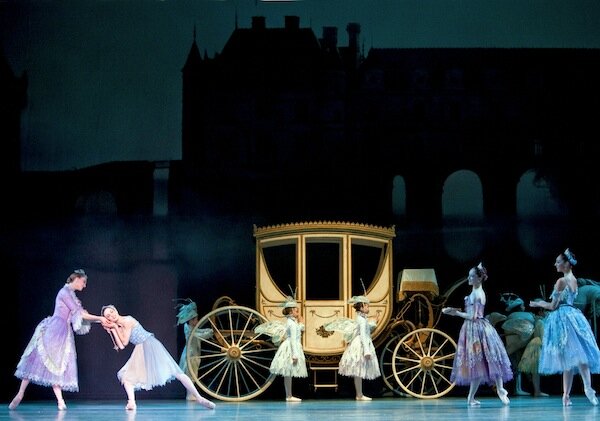 Pacific Northwest Ballet corps de ballet dancer Kylee Kitchens as Fairy Godmother and soloist Rachel Foster as Cinderella with PNB School students and Company dancers in Kent Stowell’s "Cinderella" (Photo © Angela Sterling)
Pacific Northwest Ballet corps de ballet dancer Kylee Kitchens as Fairy Godmother and soloist Rachel Foster as Cinderella with PNB School students and Company dancers in Kent Stowell’s "Cinderella" (Photo © Angela Sterling)
This is a ballet that draws adorable little moppets like nothing else. They may fade a little at an evening performance; I saw a few fathers heading out at second intermission with daughters deep in slumber over their shoulders. That's all right: They've seen the stepsisters carrying on, the carriage trip and ball's extravagant romance, by then.
Pacific Northwest Ballet's Cinderella (at McCaw Hall through Feb. 13) is like a hyper-elaborate dessert menu option, just slightly piquant, unfailing sweet, and technically impressive. Now, as a child-free curmudgeon, I don't really go in for this sort of thing, but it is actually a remarkable production. The combination of Martin Pakledinaz's glittering array of form-fitting, flowing, and wedding-cake-fantasy costumes, Tony Straiges' cinematic projections and gauzy scrims (plus the fairytale carriage), and Randall G. Chiarelli's warm-glow lighting pile on top of each other like layers of fruit and icing on a Prokofiev and Stowell cake.
If there's a weakness to Kent Stowell's on-the-bright-side telling, it's that nothing all that bad happens, people just like to dance. Cinderella has fond, beyond-a-scrim memories of her parents in former days to compensate for being ordered around like a servant, and she's so good-natured that even being skipped over for the ball doesn't really get her down. She's still playful with her stepsisters.
The dramatic stakes are just not very high--and as if to get downplay that by searching out extremes, Stowell's choreography gives some scene-stealing dancing to characters who have little dramatic reason for being (coughs, looks at jester), and explodes your head with the cute of little bug/fairy kids and clock/pumpkin children dancing like the most sincere pumpkin patch ever come to life. The little ones have real choreography to perform, and their applause is well-earned....
Director Darren Aronfosky's hyperstylized films are always about intense people driven to commit crazed acts—and they always makes me overwhelmingly uninterested in giving those passions a try. See his unbalanced mathematician in Pi, heroin users in Requiem for a Dream, the wrestler in The Wrestler (<3 u, Mickey!), and now the perfect, crazy, and perfectly crazy ballerinas in Black Swan. So yes, all those jobs are officially crossed off my When I Grow Up list. (What's Aronofsky's next film about? Wolverine. Don't want to be that either.)
If you haven't heard the descriptor a million times by now, Black Swan is the heavily buzzed-about "psychosexual thriller" with Natalie Portman and Mila Kunis as bicurious Swan Lake doppelganger frenemies. Sure, there's some hot lezzie action, but besides that It's All About Eve meets The Red Shoes meets Carrie meets The Grand Guignol, which ends up being a whole lot of nothing.
If anything, there's striking similarities between Black Swan and The Wrestler, in terms of documenting the elaborate rituals and the physical sacrifices required of both types of performers. Each film literally follows its protagonist, with the camera often right behind their heads. (Black Swan's camerawork is actually quite lovely, as cinematographer Matthew Libatque seemingly dances right along with the ballet. Also, the Rodarte costumes are to die for, obvs.)...
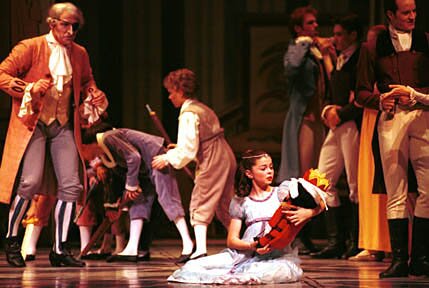 Pacific Northwest Ballet School student in "The Nutcracker" (Photo: © Angela Sterling)
Pacific Northwest Ballet School student in "The Nutcracker" (Photo: © Angela Sterling)
If you've been following The Nutcracker Chronicles, Alastair Macaulay's blog in the New York Times about his cross-country Nutracker-a-thon, you know that while the basics of the story remain largely the same from production to production, many ballet companies--large and small--employ artistic license to contextualize their Nutcracker for a local audience.
In the Nashville Ballet's production, young Clara goes to the 1897 Tennessee Centennial Exposition and her dreams take her to the land of sweets. In San Francisco, National Jewish Theatre Festival presented The MeshugaNutcracker! with the traditional Tchaikovsky music played in a klezmer style. The Tucson Regional Ballet's version is set in Tucson in the 1880's and features a battle between the coyotes and the U.S. Calvary.
With this in mind, I was wondering at last Friday night's performance what the Stowell/Sendak Nutcracker says about Seattle. I'd argue that it's: "Sure, we like our land of sweets, but it shouldn't be all fun and games, ya know." Maybe it's our Scandinavian heritage....
 Pacific Northwest Ballet principal dancers Karel Cruz and Carla Körbes in Twyla Tharp’s Waterbaby Bagatelles, presented as part of ALL THARP, Nov. 5-14, 2010. Photo © Angela Sterling
Pacific Northwest Ballet principal dancers Karel Cruz and Carla Körbes in Twyla Tharp’s Waterbaby Bagatelles, presented as part of ALL THARP, Nov. 5-14, 2010. Photo © Angela Sterling
"Cruz lifts Körbes, and then she pivots on his hands, as if about to launch herself forward into the water, and you desperately wish you could rewind that again and again," is what I wrote in my review of PNB's "All Tharp" over the weekend. So PNB's Gary Tucker did the next best thing, and sent five photos of the moment along. Click on the photo to be able to choose a larger version, but either way take a moment to let the inventiveness of Tharp's choreography embed itself in your brain. I don't know that there are any studies proving you'll be more creative as a result, but it can't hurt.
An evening with Twyla Tharp is worth making plans for, even if it's a vicarious accompaniment, through the medium of her dance works.
The three pieces on Pacific Northwest Ballet's "All Tharp" program (ends November 14) this time are Opus 111, Afternoon Ball, and Waterbaby Bagatelles, and it feels a bit like dinner date that begins with a walk through an autumn forest declaiming Keats, includes dinner at a dangerously chic nightspot with a window-view of the street, and ends with flipping through candid snaps of an Olympics swim team clowning and flirting in between meets.
Depending on which night you go, there's a special treat for PNB fans, given her impending departure at the end of the season, to see Ariana Lallone in one or more pieces.
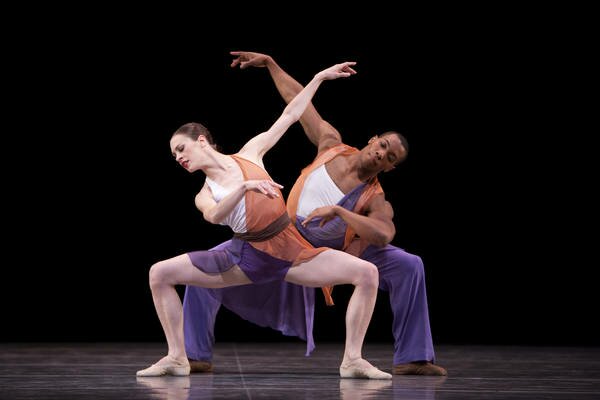 Pacific Northwest Ballet soloist Rachel Foster and corps de ballet dancer Kiyon Gaines in Twyla Tharp’s Opus 111, presented as part of ALL THARP, Nov. 5-14, 2010. Photo © Angela Sterling
Pacific Northwest Ballet soloist Rachel Foster and corps de ballet dancer Kiyon Gaines in Twyla Tharp’s Opus 111, presented as part of ALL THARP, Nov. 5-14, 2010. Photo © Angela Sterling
Brahms' String Quintet underpins Opus 111, and PNB gives you a live quintet (two violins, two violas, and cello) to enjoy. It's four movements, and you see five couples--everyone has their favorites, I'm sure, but for me the kinetic Batkhurel Bold and Carla Körbes stood out, along with a smoldering Ariana Lallone and Karel Cruz--though Tharp's mind seems equally focused on the overall picture: sides of the stage mirror each others' moves, or a movement series ripples its way through a diagonal line. I always wonder how much when you see a dance affects what you see, but something about Mark Zappone's costumes, fluttering swaths of color, made me think of the unpredictable way leaves twirl, coming down. And in any event, the dancers pirouette and spin throughout the piece, their arms almost always in motion, shoulders shrugging or pointing. They're frequently raised in a rounded "V" that near the end, when a more heel-and-toe folk-dance style arrives, becomes that fuller goblet shape you know from Russian dances, a pronouncement of hale-and-heartiness you can't help but be warmed by....
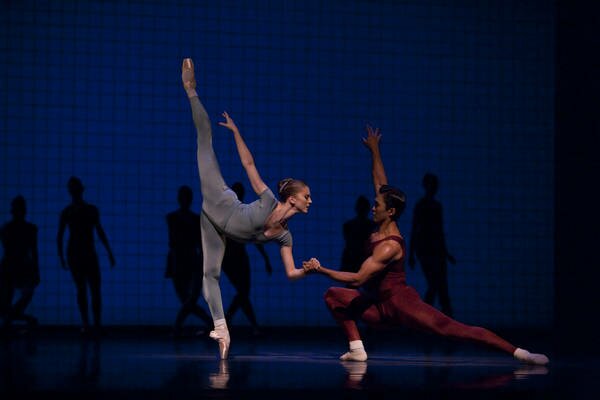 Pacific Northwest Ballet principal dancers Carla Körbes and Batkhurel Bold in Jerome Robbins’ Glass Pieces, presented as part of DIRECTOR’S CHOICE, Sept. 24 – Oct. 3, 2010. Photo © Angela Sterling
Pacific Northwest Ballet principal dancers Carla Körbes and Batkhurel Bold in Jerome Robbins’ Glass Pieces, presented as part of DIRECTOR’S CHOICE, Sept. 24 – Oct. 3, 2010. Photo © Angela Sterling
PNB's Director's Choice program has one more weekend to enthrall dance--not simply ballet--fans. Running through October 3 at McCaw Hall, it's post-Balanchine, but just barely: Three of the four pieces are from the mid-1980s.
My favorite of the evening was the finale, Glass Pieces, an against-type Jerome Robbins work that PNB's Peter Boal is personally acquainted with. Using a Philip Glass score, Robbins looks into the beehive of humanity. "Robbins wanted us to be frenzied pedestrians traversing Grand Central Terminal at rush hour," reports Boal in the program notes. The towering back wall is a gridwork that also suggest the ubiquitous tile of public spaces.
After the first movement's commute--threaded by three spare, elegant duets--a shadowed line of dancers processes slowly across the back of the stage, carrying the rhythm in their hips and knees, trading places, stepping sideways, as Glass's minimalist score also chugs its way past the fevered fingers of the orchestra.
In the second movement, Carla Körbes and Batkhurel Bold have a duet is almost purely musical shapes. It's minimalist dance--for a moment, they stand, arms lightly curving. There's a solidity and amplitude to Körbes and Bold, as if they'd been sculpted from living rock. For the third "act," Robbins has social machinery transmit the movements that gradually lead to a stage-filling ensemble, the initial regimentation blazing out in a furious complexity....
Open Flight Studio, HERE/NOW. A quarterly project of Paige Barnes at the Open Flight Studio, HERE/NOW features a lineup of randomly paired dancers and musicians who will produce improvised performances (Saturday night 8 p.m.; $8 suggested donation at the door). It's very off-the-cuff and informal, and the results can either be complete flops or brilliantly inspired. Barnes has ensured that her guests are some of the most talented artists in Seattle; past participants have included dancers KT Niehoff, Jim Kent, Michael Rioux, and Mônica Mata Gilliam, and the musicians have included Tiffany Lin, ilvs strauss, Paris Hurley, and Jeff Huston. The lineups are kept secret until the performance, though, so prepared to be surprised.
The Trails Project at Marymoor Park. One of the many projects supported by 4Culture, The Trails Project (Sunday, 11 a.m.; RSVP preferred) features three artists commissioned to produce work that engages audiences with our regional trails. At first blush, it probably sounds like one of these cheesy community events you want to avoid like the plague, but true to form, 4Culture has commissioned three pretty brilliant artists. Susan Robb is a visual artist and sculptor whose work I don't know very well, but it looks cool. Paul Rucker, on the other hand, is a pretty amazing musician, composer, and visual artist, and a pretty nice guy to boot. And as for performer Stokley Towles, his last piece Waterlines, on the municipal water system, was so strangely compelling that I can't help but highly endorse his work....
It's a PNB premiere, this Coppélia (through June 13), the latest in a line of Coppélia premieres that stretches back to 1870. (Balanchine's interpretation of Petipa's version had its premiere in 1974.) Pacific Northwest Ballet and San Francisco Ballet co-produced this one, with luxurious, fairytale scenery and costume design by Roberta Guidi di Bagno.
There's a little teapot of a house, a huge, leafy canopy that stretches the width of the stage, and a book-and-mechanical-doll-strewn workshop where Dr. Coppelius (Peter Boal) is working on his dream of a lifelike young woman. Totally not creepy, I'm sure. Be prepared for everyone to clap each time the curtain goes up. The set and costumes are of a piece with the sweetly light-hearted score from Léo Delibes (conducted with monochromatic bounce by Nathan Fifield on opening night).
In theory, Coppélia is a story ballet, though I have a suspicion that if you plotted it out minute by minute, you'd find that dance advancing the narrative made up about forty percent of the total. The rest is Balanchine amusing himself--and the audience--with dancing around this parable....
I haven't read that he was socked in the jaw very often, but I have to think that in dancers' dreams at least, George Balanchine was as much abused as adored.
I'm thinking of the moment in Serenade when Ariana Lallone pivots en pointe, one leg languorously outstretched, as a male dancer kneels behind her and, unseen, ever so slowly rotates her. Lallone's face is a perfect mask, her wrists, her fingers, not too tense, she's a living sculpture--and her body's weight shoots down through a single trembling, balancing ankle to a toe shoe.
My ankle sprained in sympathy.
PNB's "All Balanchine" (through April 25) may be the strongest of their celebrations of the celebrated choreographer's work that I've seen. The program of Serenade, Square Dance, and The Four Temperaments shows off Balanchine's remarkable ability to marry that Balanchine aesthetic to music. In each case, it's not a shotgun wedding, it's a love match. The audience on Saturday afternoon arrived head over heels, and applauded the curtain going up.
Serenade (from 1934) is a romantic vision set to Tchaikovsky's Serenade for Strings, the stage loaded with ballerinas in long tutus. When it was new, audiences reacted to it the way PNB audiences respond to William Forsythe. At one point, heedless of symmetry, Balanchine has everyone crowd into the far corner of the stage and crouch, while a soloist performs downstage. Oh, the humanity!
If there's a trained expectation he doesn't leave unsatisfied, I'm not sure what it is. Instead, there are chords of dancers, patterns and intersections drawn from the music, and contrasts between steps and rhythm. A few themes cut across each piece: Balanchine's regard for stillness, the way he uses it as a dash rather than a period at the end of a series. Those challenging one-legged landings from a leap. Extension that, even flat-footed, creates a sense of elevation....
(Last-minute Tuesday)
- Early this month, Animal Collective and Danny Perez displayed ODDSAC, a "new synthesis of music and film" at the Guggenheim museum in New York--watch the visual album @ the Egyptian tonight. On Wednesday, Deakin (Josh from Animal Collective) plays a solo set with Jabon & Peppermint Majesty @ Neumo's
Wednesday
- The Low Anthem can go from haunted to hootenanny several times within a tracklisting. Armed with classic (bellows organ), creative (cymbals played with a violin bow), and innovative (spoiler alert: group cell phone experimentation) instrumentation the transitions from the heartbreakingly effective weepers to the upbeat foot stompers provide jarring relief. With the delightfully creepy goth-folk and blues of Timber Timbre @ the Crocodile
Thursday
-
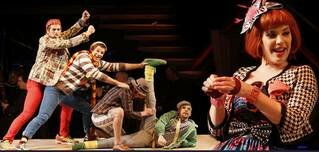 Opening: Seattle Opera's Young Artists take on Ariadne auf Naxos (through April 11) @ the Meydenbauer Center
Opening: Seattle Opera's Young Artists take on Ariadne auf Naxos (through April 11) @ the Meydenbauer Center
- Gerard Schwarz conducts the Seattle Symphony, a little Janacek and Prokofiev, plus Mussorgsky's Pictures at an Exhibition (through April 3) @ Benaroya Hall
- The League of Women Voters sorts out how to make democracy work with a panel including Nancy Amidei, director of the Civic Engagement Project; Seattle Times columnist Jerry Large; and author Paul Loeb (Soul of a Citizen) @ Town Hall
-
 Owl City goes from his parents' basement to playing @ the Paramount
Owl City goes from his parents' basement to playing @ the Paramount
- Citizen Cope and his nappy dreads play his first of three dates @ the Showbox
- FREE: Daniel Atkinson, a doctoral candidate in ethnomusicology at the UW, talks about slavery and the musical legacy of the Louisiana’s Angola State Penitentiary @ the Northwest African American Museum
Friday
- FREE: noir novelist Walter Mosley returns with a Leonard McGill story Known to Evil @ Seattle Public Central Library
- Juno may have introduced you to the Moldy Peaches; half-Peach Adam Green plays from his album Minor Love @ Chop Suey
- The Morning Benders have really come into their own on new album Big Echo. Tonight, first they play a free all-ages set @ Sonic Boom Capitol Hill, then a 21+ show @ the Croc
Saturday
- Michael Buble seems unable to escape appearing in public without being stalked by a velociraptor or two. The possibility of ferocious dinosaurs at the performance might add extra incentive to the "Crazy Love" arena tour @ Key Arena
Sunday
- FREE: Frances McCue and photographer Mary Randlett give a talk--part travelogue, part memoir, part literary scholarship--called "The Car That Brought You Here Still Runs: Revisiting the Northwest Towns of Richard Hugo" @ Seattle Public Central Library
- California-sounding Florida band Surfer Blood gets the kids riled up @ the Vera Project
- Hugh Cornwell of seminal UK punk band The Stranglers plays a solo show @ the Tractor
Monday
- FREE: David Laskin reads from The Long Way Home: An American Journey from Ellis Island to the Great War @ Seattle Public Central Library
Tuesday
- Opening: The musical Dreamgirls runs sassily through April 11 @ the Paramount
- SOLD OUT: Brandi Carlile does her singer/songwriter thing @ the Crocodile
- FREE: PNB education manager and Tudor Choir founder and director Doug Fullington talks with choreographer Mark Morris @ Town Hall
There's a fake wholesomeness to classical performing arts that I've never quite understood. I've seen it at the opera, when older patrons complained about how a director "spoiled" a pretty aria by dramatizing the rape or murder that goes along with it. Similarly, all parents subscribe to the right to drag little girls in tutus to ballet, without glancing at the program--trained, perhaps, by ballet's preference for the romances of Barbies & Kens. But this cheats the childless, for one, and parents themselves, for another, of the chance to deal with adult emotions and situations.
Ulysses Dove's "Serious Pleasures" is not for kids. Not much about PNB's "3 by Dove" (through March 28) is. The suggested anal sex, fellatio, and masturbation aside, there's a keening sexual anguish that pervades the work. It assumes that you've been there, and done...that...and that...and that. Maybe not that, but you've heard about it. From the opening, when Lucien Postlewaite as the Narrator, hooked onto two bars on the wall, unwinds himself and his kinked imagination, there's space being made for an artistic perversity. The staging is by Parrish Maynard.
"No regrets, no retreats, no looking back," Dove once said, but "Serious Pleasures" is precisely that look back--in this case, to the '80s club scene, where as a sort of sexual Orpheus, the Narrator wanders among the shades of old passions and desires. (The '80s had that effect on people--see Whit Stillman's Last Days of Disco.) Louvered banks of dark gray doors burst or swing lazily open, revealing one tight, lithe body after another. Hair swirls in backlit cascades. Women pose as if in peep show booths. The music (Robert Ruggieri) is a pounding club beat. Men (Jordan Pacitti getting his satyr on) stot their way across the stage.
It's not, actually, to shock. Dove interpolates some Balanchine technique to further show off the body erotic, but it only emphasize the leaky libidinal boats we all sail in. As Freud noted, if it's not sex, it's death, and underpinning the spectacle in this underworld of statuesque desire is a remorseful knowledge that it's all already happened, already done. And the Narrator rewinds himself on the wall, restating Henry Miller's "rosy crucifixion."...
Much like Joe Camel and smoking, Michael Powell and Emeric Pressburger's 1948 film The Red Shoes has corrupted generations of young people by giving them the idea to become dancers. The romance! The beauty! The ruined bodies, lack of steady pay, and short career that leaves you with few options other than to become a yoga instructor! Well, I may be being hyperbolic (actually I'm not), but whatever the case, the film's a gorgeous classic, wrapping the story of a young ballerina making it big around Hans Christian Anderson's fairy tale about an enchanted pair of ballet slippers. There are three more chances to see it this week at the Northwest Film Forum--if you can get tickets at the door. They're sold out online.
Classical ballet doesn't get more classical than The Sleeping Beauty, this production especially, which, as PNB's Doug Fullington explains it, has a lineage that extends right back to its original choreographer, Marius Petipa. When Kaori Nakamura, as Princess Aurora, balancing en pointe on a single foot, has each of her suitors turn her, hold, then release, four successive times, it's such an apotheosis of style that it's hard to believe a human ankle is involved. (PNB's production, running through February 14 at McCaw Hall, employs rotating casts, so your Princess Aurora may vary. Tickets are $25-$160.)
One of the humanizing qualities of such an idealized art form is that, even with notation, there's no better way to be sure of a choreographer's intent than seeing his work yourself. Ronald Hynd's wonderful version is just two choreographic generations from a 1921 Diaghilev production that toured to London, which gets you right back to St. Petersburg and Petipa.
Yet you don't think of The Sleeping Beauty as, narrative aside, slumbering unchanged for a hundred years. It exists, in Mircea Eliade's formulation, in illo tempore, in a once upon a time adjacent to the present. (On the other hand, this is a three-hour ballet with substantial action in pantomime, not a sing-along fairy tale, so while I can vouch for its immediacy, I can also vouch for the adorable little moppet behind me talking throughout, kicking seat backs, doing an impromptu dance break, beating time on an arm rest, and guzzling her way through a juice box.)
The Prologue presents the baby's christening, in a kingdom with access to yards of gold lamé--Peter Docherty's costumes start out storybook and trend towards Bedazzler--with seven fairies bearing gifts of beauty, temperament, beauty, and so on, each having a little solo. Sadly, Carabosse the wicked fairy was left off the invitations, and shows up enraged, promising deadly spindles on sixteenth birthdays, before the Lilac Fairy of Wisdom (Carla Körbes, last night) steps in to water down a death sentence into a coma....
Seattle Dance Project's "Project 3" opens tonight, January 29, and will have seven performances this weekend and next at ACT. Tickets are $25. Here is a conversation with choreographer Edwaard Liang, whose work is having its premiere.
Pacific Northwest Ballet was bustling with bunheads when I met up with Seattle Dance Project co-founder Julie Tobiason in a conference room there, before rehearsal started on Edwaard Liang's new work. It's their third season performing as part of ACT's Central Heating Lab, but they gather their rehearsal studio time while--and where--they may. Julie had her third baby with her--she's part of a maternity explosion that's hit the group, and is sitting this set of performances out.
Tell me about starting the group.
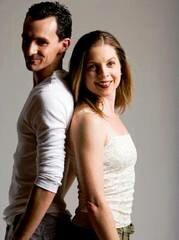 SDP founders Tim Lynch and Julie Tobiason (Photo: Angela Sterling)
SDP founders Tim Lynch and Julie Tobiason (Photo: Angela Sterling)
For us, it was like now or never. We had this great group of dancers around, and if you're going to say, "I'm going to fundraise for the next three years..." You don't know who'll be around. You just don't know. We were awarded two grants, and so that's why we started when we did. It just felt like if we wait, it's not going to happen. We're grassroots, if we realize our budget is going to be $5,000 off, we look to see what we can cut. It so bare bones anyway, but that's what we're all doing.
We started in 2007, rehearsing and getting pieces going. Our debut was with "Project 1" in January 2008. In our second year we did "Project Orpheus" in the fall, and then January 2009 was "Project 2." This season we did a collaboration with the chamber music group Simple Measures in November '09. Our idea in building repertory is to have a mix of collaborative productions and our own self-produced repertory productions.
Is everyone from PNB?
We're PNB heavy, that's part of the reason why we started. When I left I did some work with Donald Byrd over at Spectrum, I did some work with Maureen Whiting; I wanted to explore other modern and contemporary works. The ballet career--forty weeks a year, thirty to forty hours a week--I had done that since I was sixteen years old. So I wanted to do some things I felt I was motivated to do.
Timothy Lynch had retired the year after me from PNB, and I knew he wanted to continue dancing. You know, retiring from PNB doesn't mean your dance career ends, unless you decide that. We were talking about Maureen's work, and how much we loved contemporary and new works, and other dancers--Alexandra Dixon, Oleg Gorboulev was here teaching and doing some guesting, and Dana Hanson. We just had a great group of people hanging around with similar interests, so that's why we started it, really. Kory [Perigo] and Betsy [Cooper], they're from modern dance, though they trained in ballet....
Seattle Dance Project's "Project 3" opens this Friday, January 29, and will have seven performances this weekend and next at ACT. Tickets are $25.
Choreographer Edwaard Liang used to dance himself (Nederlands Dans Theater, NYCB, and for contrast, Fosse on Broadway), and demonstrating movements in rehearsal reveals himself still as buttery-jointed as a yogi. His background in dance is "all over the place," he says, and credits Buddhist and tai chi practice for the "meditative, flowy, seamless" movement aesthetic that's his hallmark, whether the piece is ballet or modern.
Like many Buddhists I've known, he admits to being a control freak, and this may be why he tells me that he loves the process of creating in the studio most. "It's not so much the pose," he says, "but how you get there." His as-yet-untitled piece for SDP is for six dancers, four male and two female. It's ballet-infused modern dance--in Michael Upchurch's story he says it's inspired by conversation, how people talk with, to, or past each other....
Special to The SunBreak by Scott Bernard.
Pacific Northwest Ballet’s production of The Nutcracker kicked off its 26th season last (Black) Friday night (it runs through December 30; tickets are $26 and up). The date was especially fitting, in that a successful Nutcracker production is to most ballet companies what successful holiday sales are to Nordstrom.
If you haven’t seen it, what makes this production different from others done in countless cities--and from the New York City Ballet/George Balanchine version televised on PBS this time of year--is its depth. With sets and costumes by Where the Wild Things Are author and illustrator Maurice Sendak, this production benefits from his tendency to embrace the darker side of childhood.
Napping on Christmas Eve, young Clara dreams of her godfather, Herr Drosselmeier, who conjures a valiant Nutcracker character to protect the lovely Princess Pirlipat from the evil Mouse King. That doesn’t go so well, the Nutcracker is defeated, and the Mouse King bites the Princess. Fail.
Later that evening at a Christmas party hosted by her parents, Clara receives the gift of a Nutcracker doll from the dysfunctional, eye-patch-sporting Drosselmeier. Her little brother Fritz is given a Mouse King doll, and doing what little brothers do when egged on by their bizarre godfathers, chases Clara, breaking the Nutcracker doll. Drosselmeier bandages the Nutcracker with his handkerchief, and dancing ensues. The guests slowly leave, but not before Dosselmeier whispers to Clara something that seriously creeps her out. (Where is Chris Hansen when you need him?)
When Clara gets out of bed at midnight to find her Nutcracker, she trips over and injures one of the little mice scurrying about. This ignites sectarian tensions between the mice and Nutcracker loyalists. Battle ensues, and the Nutcracker army wins (Mission Accomplished!) thanks to a shoe thrown by Clara. As a reward, the Nutcracker takes the suddenly adult Clara (sorry, Drosselmeier) to what looks to be one of Saddam’s palaces, where dancers from various countries perform for their viewing pleasure.
As young Clara, Eileen Kelly had the right presence and grace. Daniel Bryson-Deane was terrific as her little brother Fritz, bringing a genuine touch to the role without going over the top. As the adult Clara, Carla Körbes danced with technical precision, lyricism and feeling. Stanko Milov was a perfectly fine Nutcracker, although there wasn’t much chemistry between Körbes and Milov. Arianna Lallone danced the role of the Peacock in the way that only she can. (Hers are seriously tough pointe shoes to fill.) The excellent PNB corps was a bit out of sync in the snow scene at the end of Act One, but was tight for the Waltz of the Flowers, led by Mara Vinson....
If you've only ever seen Romeo and Juliet in Shakespeare's tragedy, bathing in the incandescence of its lyrical fireworks, you've seen only half the story that could be told. Pacific Northwest Ballet's Roméo & Juliette (at McCaw Hall through October 4, tickets $25-$160) takes the black-and-white of words, words, words, and transforms it into the technicolor of bodies in motion. That PNB can field the likes of Carla Körbes, Lucien Postlewaite, Olivier Wevers, Jonathan Porretta, and Ariana Lallone moves us into metaphorical HD territory.
Jean-Christophe Maillot's choreography would be arresting if you weren't so engrossed in simply watching it unfold the story of our two doomed lovers. As in the best musicals, when it feels somehow inevitable for a character to burst into song, with Maillot you feel flashes of recognition as ballet is reconstituted to mean something again.
When I first saw this production, I set aside Maillot's reworking of the role of Friar Laurence. On second viewing, I have to admit I was too caught up in the feverish spectacle the first time to see what Maillot is up to. His ballet, after all, begins with Friar Laurence, who will spend the intervening time until the tomb aiding and abetting love's course, and impotently trying to forestall tragedy.
He's a counterpart to the score by Prokofiev, in which every unchained melody hovers over an ominous, rumbling murmur from the pit. He's a counterpart to us, the audience. Opening the evening as he does, he returns with us to the scene of the trauma Western civilization can't seem to escape (we've been retelling the story for over 500 years). If you think about it, there's complicity embedded in the desire to hear the story one more time.
Perhaps that's why Maillot has given Friar Laurence (and the fiendishly talented Olivier Wevers) a modern dance vocabulary--attired like a Jerome Robbins escapee, Wevers ties himself in knots of conflicted aims. He floats in and out, darts between the two lovers like an interfering ghost, spirits Juliette away into a pas de deux of abnegation. In the play, a vial of poison sounds like a plan--in dance, it's a seduction.
It's hardly possible to make too much of the teenage heat thrown off by Maillot's Roméo and Juliette. It's not the airbrushed trapped-in-TV-amber artifact of the CW's 90210 retread (Future Anthropologist: "They fetishized a fantasy of recycled adolescence"), but is full of stumbles, stolen kisses, awkward strainings, and blind gropings. I did not stop to count the number of feels copped in the ballet, but you almost expect to see a separate grab-ass choreography listing. The crudeness is refreshing....
Yesterday we mentioned that there'd be a kite ballet going on at Gas Works Park all day today. The more Jeremy and I thought about it, the more it sounded like a terrific lunchtime break. So off I went, camera in hand.
Closer to the park, we could see the kites scudding in a steady northeasterly breeze. When the wind slackened, they dipped toward the ground. "This is great," said a passerby, wandering beneath the swooping kites. "They're like friendly ghosts."
There were plenty of kites still to be put in the air just after noon. The whole 121-kite fleet should be quite a sight.

Most Recent Comments